Hi there! Some of you may have followed my blogging during my two-year weight loss journey, from March 2009-March 2011. Today, I’m starting another experiment that is related to my health:
Note: I will blog here every Wednesday about what I’m learning, starting tomorrow, Oct. 17. Thanks, in advance, for your support.
Search Results for: weight loss journey
To Win, Back Yourself Against a Cliff
I am a goal-oriented person. I always am working on a goal, or ten.
From time to time, I refer to the goals I set as Ulysses pacts. A Ulysses pact, or contract, is a self-made decision that binds one to the future. The term refers to the pact Ulysses (Odysseus) made with his men as they approached the Sirens. Sirens were the three dangerous bird women/seductresses who lured nearby sailors with their enchanting music to shipwreck on the rocky coast of their island.
Ulysses wanted to hear the Sirens’ song but he knew doing so would render him irrational so he put wax in his men’s ears so that they were unable to hear, and had them tie him to the mast so that he could not jump into the sea. He then ordered them not to change course under any circumstances, and to keep their swords upon him to attack him if he should break free of his bonds. (Source: Wikipedia.org)
I set many goals and achieve most of them. And while I don’t take it to the extreme that Ulysses did, I understand his thinking. I absolutely credit the achievement of my goals to my level of commitment to them, and to the fact I tie them to short-term consequence(s) with no chance for compromise. I’m sharing what works for me here in hopes it will be of value to others.
It’s pretty easy to decide to do something. How many of us decide we’re going to eat healthier starting this week? But we don’t. Or we’re going to start going exercising again, and/or we’re going to join a gym. But we don’t. We are going to limit our alcohol consumption, or give up smoking. But we don’t. We are going to start saying “no” more often. But we don’t. We are going to spend less time watching television. But we don’t. We are going to read more. But we don’t. The list goes on. We all do it.
Deciding, while it’s a start, is not enough. I think pretty hard about something I want to achieve before deciding it is a goal. Then, I commit. (Deciding and committing, while they go together, are not the same things. The distinction is critical. Please watch this video for more.)
Further, if the goal is too big, or too vague then it’s likely the goal won’t be achieved. I would have little chance at succeeding if I were to say, “I want to be healthier” or “I want to watch less television.” The goal needs to be very specific, with no ambiguity. As Chip and Dan Heath so effectively put it in their awesome book, Switch, we should “shrink the change” (make the goal not so vague or big) to increase our likelihood of success.
For me to have any chance at succeeding at a goal, I make a big deal of it to those closest to me. I need not only their support, but also, very importantly, their accountability.
So commitment is the first requirement. Tying the commitment it to short-term consequence(s) is the second.
Neuroscientiest David Eagleman, in an EXCELLENT Radiolab.org podcast, called “Help!,” says one of the best strategies for breaking a habit or making a change or achieving a goal is to tie it to “some sort of emotional salience — some reason why they matter to us right now, otherwise they will never work.”
A personal example is my weight loss journey that started in March of 2009. After three years of growing lazy, overweight and out of shape, the feeling of disgust and regret that I met with every single night when I went to bed served as the best motivator and consequence in my mission to lose weight and get healthy again.
My goal was a long-term one – to be a vibrant mother and wife who takes care of her health and body. But the short-term consequences were what did it for me and kept me true to my commitment to good health once I set that goal. I tied the future goal to a short-term feeling of disgust and regret. I did not want to feel that way. So my battle became a battle of disgust vs. desire (to not exercise and to keep eating too much junk food). In my humble opinion and experience, disgust almost always wins over desire.
Thomas C. Schelling is a Nobel Peace Prize-winning economist who has written a lot about the idea of commitment. (Being a fanatic about commitment, I enjoyed his Strategies of Commitment, which I highly recommend.)
In the same, aforementioned Radiolab podcast, Schelling talks about arranging commitment “so you can’t compromise.”
An example he gives is from ancient Greece. A Greek being pursued by a huge army of Persians had to make a stand on a hillside, and one of his generals said “I don’t think this is a good location to make our stand. There is a cliff behind us. There’s no way we can retreat if we need to.” He told the General, “Exactly.”
Schelling personally enlisted this strategy in his own life. In the Radiolab.org podcast, Schelling tells of his own win over smoking. In 1980, after many failed attempts to quit smoking, he gathered his children together, and told them, “I quit.” But that wasn’t all. He told them they “should never have respect for their father again” if he returned to smoking. Guess what? He never smoked again.
I will give one more example of a goal of mine with short-term consequence, which is far less significant than giving up smoking, but illustrates the effectiveness of the strategy this post is about.
I’m on Day 7 of a 30-day “no nuts or fruits” pact. If I screw up, my short-term consequences for the week are: 1) I cannot have the scoops of ice cream I have on Friday with my sons during our traditional weekly ice cream social, and 2) I have to train/exercise in the streets of Lander, which would mean forgoing the trails in the canyon, foothills and mountains above town, where I prefer to train. (Of course, fruits and nuts are good for a person. But I eat an excessive amount of both, so this is simply a pact to clean my slate on these items before reintroducing them at reasonable and healthy levels.)
By the way, upon hearing the Sirens’ song, Ulysses was driven temporarily insane and struggled with all of his might to break free so that he might join the Sirens, which would have meant his death.
But this is beside the point. He survived AND he didn’t give in to the Sirens. Right? Thanks for listening, and good luck with your goals.
Shelli Johnson is a life/leadership coach. Her business, YOUR EPIC LIFE, Life Should Take Your Breath Away, combines coaching with an epic adventure. Email her for more information.
RELATED POST:
Self Control is an Exhaustible Resource
Spain or Bust: Camino de Santiago, Here We Come
“Twenty years from now you will be more disappointed by the things you didn’t do than by the ones you did. So throw off the bowlines, sail away from the safe harbor. Catch the trade winds in your sail. Explore. Dream. Discover.” –Mark Twain
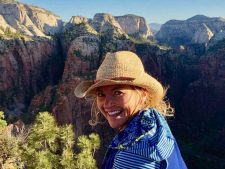
Our Epic family trip is fast approaching, and we are so excited! We’ll spend a few days in Paris, then we’ll fly to Spain, where we’ll start out in Madrid for a couple of days, before embarking on the main part of our Adventure – our 160-mile pilgrimage on the Camino de Santiago. We’ll mark the end of our pilgrimage in Santiago de Compostela, before flying to Barcelona to celebrate the last four days of our Epic trip.
Four years ago, my husband, Jerry, and I resolved that we – our family – were going to start taking almost-month-long vacations. We have three sons, Wolf, 18, Hayden, 16, and Fin, 11. We have always enjoyed many family trips and adventures, but, until three years ago, we had never gone on a trip that lasted more than 7-10 days. What a gift it would be if we could take an entire month to experience new places, sights, cultures and activities as a family.
As a parent, I doubt myself often. I don’t boast a lot about my parenting abilities, but this idea is one I’m so proud of, and as parents, it’s definitely one of the best ideas Jerry and I have had.
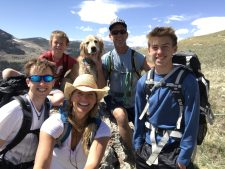
Some people may wonder how we can take a month off to make a trip every year. That’s a good question. It’s not easy, and it hasn’t always been possible. Our ability to do so is hard-earned and intentional. Having the time available is a gift. For us, time is worth more than money. Jerry’s a teacher, so he and the boys all get out of school at the end of May each year. Jerry didn’t always have his summers free, though. When we had our first company, Yellowstone Journal and YellowstonePark.com, for 15 years (from 1994-2008), Jerry’s summers were spent working tirelessly delivering magazines and helping me with the company. He worked so hard for so many years, logging endless hours and miles on the road. Fortunately, since selling that company in 2008, Jerry’s summers have been his. As for me, I work for myself, and since starting Epic Life Inc. in 2011, I have kept my summers mostly free.
These trips aren’t cheap even if we do our best to be frugal. We don’t make a very big income, but we are careful about our spending throughout the year, and over the years, have worked to eliminate most of our debt. We don’t live lavishly. (Our house needs a lot of work and updating, but we have not made it a top priority in the interest of this travel we’re wanting to do at this stage of our family’s life. We seldom go out to dinner, in an effort to save money for travel, and so on.)
That said, it would be easy to not embark on these trips. They are big undertakings, especially when they’re a month long and involve international travel, and a family of five that includes three growing boys with insatiable appetites for food. It would be easy to chicken out and say No. But we want to say Yes, so we book them far in advance, when we’re initially inspired, so we can’t draw back.
In 2016, we made our first international trip and explored several countries in Europe. It was an unforgettable experience that included time in London, Munich, Switzerland, Italy (Moneglia and Rome, etc.), and Portugal. We visited numerous historic and cultural sites, hiked many miles in Switzerland and Italy, drank beer and wine, indulged in the many delicious and unique foods of the countries, and met so many kind and interesting people. Plus, we successfully made about 100 train connections, which is no small feat for these country bumpkins from Wyoming! We kept a family journal, and each of us wrote something at the end of each of our 30 days in Europe. Each of us walked, on average, 13 miles per day, which is indicative of how much we saw and experienced. Every time we arrived to a new destination, by train, we’d hike 1-3 miles to discover what our accommodations would be like. It was all new and exciting and unforgettable, and to do it all as a family, was/has been such a blessing.
Then, last year, in 2017, we started in Vancouver, B.C., where we rented a van and enjoyed a month-long Epic Road Trip that took us all the way south to Los Angeles. From Vancouver to the San Juan Islands to Seattle, to Portland, to the coasts of Washington, Oregon and California, we immersed ourselves in the cultures of the cities, the wonderful environs of several national parks and beaches, and had another unforgettable adventure.
We still revisit, often, various aspects of both of our Epic trips, which, of course, is what Jerry and I were hoping for when we had this idea of the longer family trips. We wanted for us to create lasting memories and experiences that our family would be able to share forever.
Before continuing, I ‘d like to be completely transparent about something. I would be lying if I said these big trips, and the destinations we choose, have been family decisions. For the most part, they haven’t included a very democratic process. Rather, for the most part, Jerry and I have determined where we’d like to take the family, and then we share our dreams of the particular travel plans, and, at least so far, the boys have been excited and quickly jumped on board.
By the way, whenever it has come to something Jerry and I feel strongly will benefit our family, we have used this tactic. For example, when we first started our family, Jerry and I resolved that we wanted to be an outdoors family. I wrote an article, called “How to get your kids to hike” that explains how we went about raising an outdoors-oriented family. But for purposes of the point I’m trying to make here, I’ll cut to the chase. Whenever we wanted to take the kids hiking, we did not ask them, “Do you want to go hiking today?” Instead, we’d enthusiastically announce to them, “Today, we’re going hiking!” This simple strategy worked, and today our boys are great hikers, and we’ve spent the last 18 years adventuring with them.
When it comes to goals and values you’d like to instill in your family, I highly recommend this strategy. We are the “captains” of our families/kids for only so long, and Jerry and I are trusting that the decisions around travel and outdoors that we have made for our boys, and our family, will offer them lasting benefits.
But back to our upcoming trip. No question, I think Jerry and I are more excited about the Camino de Santiago portion of our trip than our boys are. While we’ll explore cities like Paris, Madrid and Barcelona, our itinerary’s main item includes 160 miles of trekking. Although by now the boys are getting more excited for the experience, I think it’s fair to say choosing a 160-mile-long walk wouldn’t have been their first pick. 🙂 (It’s so funny, when we were first considering this trip last Fall, while at dinner, we’d talk with the boys about the Camino de Santiago and the pilgrimage aspect. And then one day around that time, as I was walking with Fin to school, we were talking about the prospects of such a trip, he said, “You mean we have to walk?” LOL. Um yes, and then thinking to myself, Weren’t you listening at any of our recent conversations?)
Our boys are big hikers and quite experienced when it comes to the outdoors. Most of our trips and adventures include hiking and/or camping. In Switzerland, we had two different day hikes that were about 20 miles each, and the boys, as long as we fed them often and generously, were champs! Over the years, we’ve taken them on backpacking trips, but those have been no longer than 3-4 days each.
This trip’s pilgrimage on the Camino de Santiago will include 11 days of nothing but trekking. Day after day of nothing but walking. Some of our days are big, including our first and third, which will be 20-plus miles each. The other days range from 12-16 miles. So we’ve been training for the occasion, and these training hikes have added to the experience as we’ve had some memorable times in our “backyard,” the foothills of Wyoming’s Wind River Range.
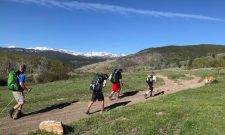
Why make trekking the Camino de Santiago a part of our big trip this year?
For starters, we can credit Martin Sheen and his son, Emilio Estevez. About six years ago, Jerry and I rented the movie, The Way. The movie, written and directed by Estevez, and starring Martin Sheen, is about a father who travels overseas to recover the body of his estranged son who died while trekking the El Camino de Santiago, and decides to take the pilgrimage himself. The movie is fantastic, and after seeing it, Jerry and I were both inspired to someday make the pilgrimage ourselves. Then, in recent years, and months, I’ve read books, and blog posts, and social media posts by people on pilgrimage. Friends, and friends of friends have shared photos and videos and personal accounts that have all re-inspired me about the Camino de Santiago. Various friends I know from my small town of Lander, WY, and the surrounding area, made the pilgrimage as recently as last year and have inspired us. Laureen Lund has a fantastic blog that includes her daily accounts of the experience. The best documentary, in my humble opinion, is Walking the Camino. We also read the book, and watched the documentary called I’ll Push You, which I highly recommend, whether you have interest in the Camino or not. Other great books I’ve read are The Pilgrimage, by Paulo Coelho, Pilgrim Strong: Rewriting my story on the way of St. James, Sunrises to Santiago: Searching for purpose on the Camino de Santiago, as well as others. All of these have stoked the fire in me that was started when I originally learned about the Camino.
During a Fall hike last year, Jerry and I were brainstorming ideas for our family’s trip this summer, and I mentioned the Camino. We talked about how in Spring 2019, Wolf will will be graduating high school and leaving the nest, and the next year, it will be Hayden’s turn. Fortunately we will have five years after that before our youngest son leaves the nest. The realization that we have only a short time remaining that our whole family will be living under the same roof together ultimately inspired us to want to do this trip, and to do it right now. (I read somewhere that 80% of the time we will spend with our children happens between their birth and age 18. As parents I think we know this, and yet being reminded of it is helpful.)
A pilgrim is a person who journeys to a sacred place. The Camino de Santiago is certainly a sacred place. Often referred to as The Way of Saint James, the Camino de Santiago was one of the most important Christian pilgrimages during the Middle Ages. Legend has it that the remains of Saint James the Great, one of the apostles of Jesus Christ, were carried by boat from Jerusalem to northern Spain, where he was buried in what is now the city of Santiago de Compostela. Once to Santiago, pilgrims often celebrate mass at the spectacular Cathedral of Santiago de Compostela, which marks the traditional end of the pilgrimage route.
Certainly, to walk where millions of others have walked before us in the interest of searching for meaning and to deepen their faith or spirituality will be such a unique experience, and an honor. I’m excited to be a pilgrim, and for my family to be pilgrims, even if it’s for only 11 days.
A pilgrimage is a journey. (In my work – whether in my coaching, or my epic adventure guiding – I’m often trying to lead my clients on an inner pilgrimage. A journey to discover more about themselves, and to, in the process be open to exploring and taking chances.) I know firsthand, and also from my observations of those I work with, how powerful such a personal journey can be. I’m excited beyond words to be embarking on a pilgrimage as a family. The pilgrimage has the opportunity to transform our family in some way, while affecting each of us individually in unique ways.
For days, our only objective will be to put one foot in front of the other. While it will certainly at times be physically challenging, the other aspects of the pilgrimage are what really intrigue Jerry and I.
Many follow a route of the Camino de Santiago as a form of spiritual path or retreat for their spiritual growth, or any number of very personal meanings.
The Way can take one of dozens of pilgrimage routes to Santiago de Compostela. Traditionally, as with most pilgrimages, the Way of Saint James began at one’s home and ended at the pilgrimage site. However, a few of the routes are considered main ones.
We will be following the Camino Francés – or, The French Way.
During the Middle Ages, the route was highly travelled. (In the 14th Century, a million pilgrims from throughout Europe wold make the pilgrimage every year.) However, the Black Death, the Protestant Reformation, and political unrest in 16th century Europe led to its decline. By the 1980s, only a few hundred pilgrims per year registered in the pilgrim’s office in Santiago. In October 1987, the route was declared the first European Cultural Route by the Council of Europe; it was also named one of UNESCO’s World Heritage Sites. Since the 1980s, the route has attracted a growing number of modern-day international pilgrims.
Today, about 300,000 pilgrims from throughout the world make the pilgrimage each year.
From here on out, I’ll take the lazy route and include some particulars about our journey in the form of bullet points. Feel free to leave a comment if you have questions about anything that might be of interest that I have overlooked.
• We’ll start our trip with 3 days in Paris, taking in the sights and foods there. At least by our family’s standards, this portion of the trip will find us “living large. ” 🙂
• Then we’ll fly to Madrid, a city we will explore for two days.
• On June 5, we’ll send most of our luggage off, to be transported to the end of our journey, and we’ll head to Astorga. Our pilgrimage will begin on June 6.
• The entire Way is 790km/490 miles. Many people take 30-50 days to walk its entire length. Others will do a portion of it, and return in future years to complete the entire path. As for us, and this trip, we’ll be dedicating 11-12 days to our pilgrimage, and we’ll walk about 160 miles.
• It’s a good thing we’re from high country in Wyoming, and that we’re hikers because we will have some big days, including days 1 and 3, when we’ll walk about 22 miles. Other days will be 12-16 miles each.
• Staying in the albergues/hostels are a big part of the Camino de Santiago experience. I understand that. But we have instead opted to stay in Inns along the way. We have reserved private accommodations for our nights along the Camino. This may seem less adventurous, but after reading accounts of “100 snorers,” our decision was made. I already have 4 personal snorers with me, but also, in addition, due to some of our big mileage days, having some personal space each night feels important to us.
• All of the great books I’ve read include pilgrims’ accounts of carrying wine in their backpack, or enjoying wine along the trek. Okay, okay. Twist my arm and sign me up for some of that. 🙂
• Siestas. I think the whole family is excited about Siestas. Especially if we are in the middle of a big uphill, and suddenly it’s “Siesta time.” We will want to honor the traditions…
• We’re looking so forward to all of the people we meet along the way, and to hearing their stories, and to sharing such a meaningful experiences with “strangers” who are from all over the world. We are each/all likely to make some new friendships.
• I used to know Spanish pretty well. I took Spanish in high school and for two years in college. Unfortunately, I don’t remember much of it, so I have been using the Duolingo app to learn some words and phrases. Wolf and Hayden are pretty good at Spanish, and they are looking forward to trying their best to use the language. We will rely on them to help us communicate our needs along the path, and in Madrid and Barcelona. That will be fun.
• Each of our family members has a “Credencial de Peregrino.” This document dates back to the middle ages, when it was given to pilgrims as a safeguard. This Credencial is only for pilgrims on foot, bicycle or horseback, who wish to make the pilgrimage with a Christian sentiment, even if it is only with an “attitude of search.” The Credencial has the purpose of identifying the pilgrim, provides access to hostels offered by the Christian hospitality of the Way, and to serve as certification in applying for the “Compostela” at the Cathedral of Santiago, which certifies you have made the pilgrimage. Each of us will collect two stamps on our Credencial at every village, etc., we pass through.
• Scallop shells. The scallop shell, which is often found on the shores in Galicia, has long been the symbol of the Camino de Santiago. When we booked our trip several months ago, we bought scallop shells and then had the idea that we should draw names, and then design the shell for the family member whose name we drew. This was really meaningful. Last night we presented each other with the designed shells, which will be attached to our backpacks during our pilgrimage. (See photo of our designed shells at the bottom of this post.)
• Rocks from home. The highest point of the pilgrimage is a place called Cruz de Ferro, marked by a towering iron cross. Since the 11th Century, pilgrims have been bringing a stone from their homeland to the Cruz de Ferro. Once there, pilgrims approach the small hill with silence and respect, before placing their rock at the cross. This symbolizes a release of burdens. On one of our training hikes, the main objective for everyone was to find a special rock for purposes of leaving it at the Cruz de Ferro. (See photo of our rocks and brief explanation of why we picked the ones we did.) Most importantly, I have been thinking a lot about the “burden” – what I want to leave behind – on this journey. As a mother, I find I’m grasping. I know it’s understandable that I am trying to hold on tightly to my boys and my/our time with them. Wolf’s leaving in a year, and Hayden’s leaving in two years, and my worries about that are causing this grasping. But I know I need to work to not grasp, to trust and to sort of let go. I’m pretty sure whatever I try to leave on the Camino will be related to that. (If this struggle is something you’re contending with, you might check out these two gems I’ve been meditating on so frequently I have them almost memorized: On Children, by Kahlil Gibran, and She Let Go, by Rev. Safire Rose.)
• We will end in Santiago de Compostela, so we’re starting about 160 miles out from there, near Astorga. We are looking forward to celebrating our pilgrimage’s end in Santiago, where we’ll stand in line to get our stamped Credencials validated and receive certificates for our pilgrimage.
• At Santiago, a highlight for us will be to attend mass at the extraordinary Santiago De Compostela Cathedral. I can imagine it will be one of the most meaningful and unforgettable masses we’ve ever attended. One of the most interesting elements about the cathedral is the famous Botafumeiro, a large censer which disperses incense amid the congregation. Weighing 117 pounds and measuring 5 feet, it is one of the largest in the world, and is suspended 65 feet high above the crowd via a system of ropes and pulleys. On special occasions, and after some masses, the Botafuemeiro is released by team of eight tiraboleiros who swing it across the cathedral at great speeds of up to 42 miles/hr).
• It is thought that this tradition of spreading so much incense over the mass was started in order to cover up the smell of the thousands of pilgrims arriving at the cathedral after their exertions. We’ll soon be among those sweaty pilgrims, and I am pretty certain the incense will be a most welcome scent!
Finally, the Camino de Santiago pilgrimage will surely present us with challenges and blessings. What the journey will mean for each of individually and as a family is a mystery. And I love that it is.
Marcel Proust wrote, “The real voyage of discovery consists not in seeing new landscapes, but in having new eyes.”
We will see new landscapes on this adventure, but we are also sure to return with new eyes.
Thank you so much for reading this blog post, and following along, as I blog from The Way. I really appreciate your stopping by and taking an interest. Truly.
(Note: The guidebook we are trusting for most of our pilgrimage along The French Way is A Pilgrim’s Guide to the Camino de Santiago: Camino Francés.)
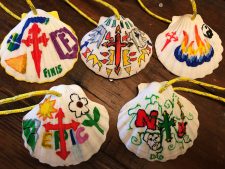
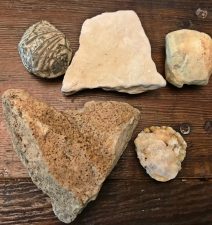
Video of a training hike:
HERE ARE DAILY BLOGs FROM OUR UNFORGETTABLE CAMINO PILGRIMAGE:
Day 1 on the Camino de Santiago.
Day 2 on the Camino de Santiago.
Day 3 on the Camino de Santiago.
Day 4 of the Camino de Santiago.
Day 5 on the Camino de Santiago.
Day 6 on the Camino de Santiago.
Day 7 on the Camino de Santiago.
Day 8 on the Camino de Santiago.
Climbing Wyoming’s Hidden Giant, and its Tallest Mountain, Gannett Peak
“You cannot stay on the summit forever; you have to come down again. So why bother in the first place? Just this: What is above knows what is below, but what is below does not know what is above. One climbs, one sees. One descends, one sees no longer, but one has seen. There is an art of conducting oneself in the lower regions by the memory of what one saw higher up. When one can no longer see, one can at least still know.”― René Daumal

As I write this, I feel exhilarated and inspired. You see, I got to stand at the top of Wyoming’s tallest mountain, Gannett Peak, last Thursday.
I hike about 1,000 miles a year, and I’ve climbed several peaks, including Wind River Peak, Fremont Peak, East Temple, Mitchell Peak, Lizard Head, the Grand Teton, Mt. Whitney, and others. But until last week, I had never even laid eyes on my state’s tallest mountain. So excuse me for my exuberance, but now that I’m back in the lower regions, I’m remembering what I saw higher up…
And, just so you know, this is a very long blog post. As Mark Twain said, I would have written less, but I didn’t have time. I am behind at work from being in the wilds for 6 days, and yet I wanted to capture this experience, and to share it with others, while it’s so fresh in my mind. So, thank you in advance if you read what is a long-form article.
The very isolated Gannett Peak stands 13,809’ tall. It is the high point in all of Wyoming, and that fact is what draws many to the area to climb the mountain. For the record, Gannett’s status as being the high point in Wyoming is actually not the main reason I wanted to climb it. I was most interested in seeing what is very much, despite its height, a “hidden” mountain. I also wanted to see and travel over some of the last remaining glaciers in the Lower 48, including Gannett Glacier, on the north side of the peak, which is apparently the largest glacier in the Rocky Mountains south of the Canadian border. I’m always looking for interesting experiences, and climbing Gannett fit the bill, and then some.
I am in mountain climbing shape, and have years of backpacking experience, but I don’t have technical mountaineering expertise. So to climb Gannett, I signed on with Jackson Hole Mountain Guides for a guided expedition.
There were two others signed up for the same expedition – Rick, from Texas, and Robert, from Mississippi. Rick and Robert are “High Pointers.” If they could summit Gannett Peak, it would be #47 out of 48 for them. (BTW, since my return, I think I am talking with a bit of a Southern accent, the result of being around Rick’s and Robert’s charming southern voices for 6 days.)
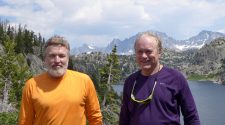
Nate Opp would be our guide. Nate was one of the guides who led me up the Grand Teton in 2009, and I like his style, so I was psyched he would be the one facilitating the meaningful adventure for us.
From what I can tell, there are three ways to approach Gannett Peak, from the West, via Elkhart Park, or from the East, via Glacier Trail, near Dubois, WY, or via Ink Wells and the Wind River Indian Reservation (with permits, etc.)
The expedition would be six days, which at first to me, seemed like a long time required to climb a peak. (I don’t recommend it, but I’ve climbed Wind River Peak, and other lesser peaks, in a single day. Most often, though, I will take 3-4 days to hike a long ways and climb a single mountain peak in the Wind Rivers.)
But when I looked at the maps, six days made perfect sense. Anything less than that, from the West side, seemed almost unreasonable, given variables like the weather, and snow depths and conditions, the altitude, etc. I could have signed on with another reputable company and approached from the East side, which was closer to my home of Lander, and the expedition would have required only 5 days’ time. But when I saw the route from the West approach, and realized it went through Titcomb Basin, I was even more excited. I had been into Island Lake and into Indian Basin (and up Fremont Peak) before and it is one of the most stunning regions I have ever seen.
“Summer breezes caressed me, my legs stepped forward as though possessed of their own appetites, and the mountains kept promising. I stopped before the trees were gone, not ready that day to disappear entirely into the vastness. Perhaps these spaces are the best corollary I have found to truth, to clarity, to independence.” – Rebecca Solnit, A Field Guide to Getting Lost
Day 1: I love that quote from one of my favorite writers and books. We started at Elkhart Park trailhead, near Pinedale, WY. From there, we hiked 13 miles, passing many beautiful lakes, including Barbara, Hobbs, Seneca, Upper Seneca, Island and others. As soon as I started hiking, my legs stepped forward as though possessed of their own appetites, and the mountains kept promising…
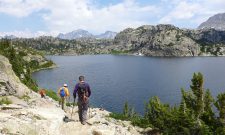
We pitched our tents in Titcomb Basin, just past the Indian Basin Junction. We had a huge waterfall feature right near our tents, that included several cascades that drained into a lake that was below, in view from our tents. We had stellar views, including one filled with jagged granite peaks and glaciers that beckoned. If all went well, we’d soon find ourselves deep in those mountains and glaciers…
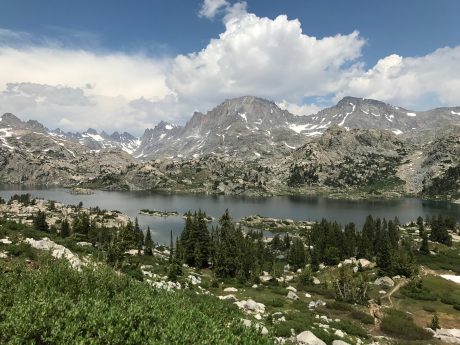
We hiked efficiently and arrived, and had our tents pitched by 3pm. I lounged around like a marmot on a big slab of granite under the warmth of the sun, while drinking in the waterfall soundtrack and the breathtaking views.
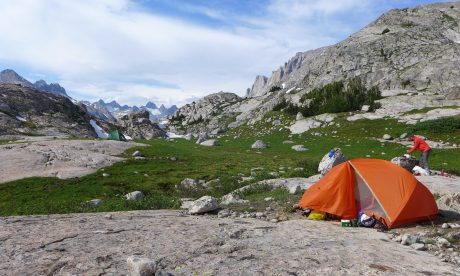
The lounging lasted only an hour or so before the weather changed drastically, and we raced for our tents. While in my tent, thunder echoed raucously against the granite towers that surrounded us, followed by lightning that lit up my tent. I am terrified by lightning, and this reminded me of a night at Clear Lake with my family that was the most scary night of our lives.
That night, lightning lit up our tent repeatedly and thunder roared as rain poured down for several hours. I never prayed so hard, and it felt miraculous that we had survived the night. I had hoped to never find myself so high up in a tent under those circumstances again, which I know is an unrealistic hope. If I am going to play in the high country, there will almost certainly be some thunder and lightning. (And it didn’t help that I recently read the fantastic book, A Bolt from the Blue, about the terrifying (and heroic) rescue in 2003 at 13,000′ on the Grand Teton. The page-turner-of-a-book tells the true story about a colossal lightning bolt that struck and pounded through the body of every climber in a group of six.
I know, I know – these things are not helpful when laying alone in a tent at 10,500′ that is getting lit up by lightning just seconds after raucous thunder echoes against the nearby granite mountains… I work with leaders and coach people all the time about the opportunity we have to “choose our mindset.” The late Viktor Frankl, an Austrian psychiatrist and a Nazi concentration camp survivor who wrote the influential Man’s Search for Meaning, argued that the last of the human freedoms that cannot be taken from us is our choosing how we will respond to our circumstances. I remembered this, and the work I do, and tried to change my “I’m going to be struck by lightning and die out here” mindset to “What a spectacular storm!” mindset. It didn’t work, but it wasn’t for a lack of effort.
So I lay there, uneasy and a little bummed that this adventure was off to this kind of start. I got out my journal and found notes from each of my three sons and my husband in the back. I read those a few times, and felt comforted. I know how blessed I am to have a family who supports these epic adventures of mine, and their thoughtfulness touched me. Luckily, the storm was short-lived. After about an hour and a half, the storm passed through, and we had blue sky and sunshine again.
After emerging from the storm, and our tents, Nate made us an epically delicious dinner of tacos, complete with guacamole, and peppers and salsa. We all ate like people who were super duper hungry. 🙂
I was getting to know Rick and Robert by now. After hiking several miles together, and now having shared our first meal together, we were acquaintances. I liked them immediately. They are kind, Southern gentlemen.
For the first time since starting Epic Life Inc., I chose to forego leading my flagship program, Epic Women, this summer. Every year at this time, I am leading my Epic Women expedition in the Wind Rivers. I coach women individually for several months, and then they all come together to meet for the first time, and we go into the wilderness to backpack and climb mountains.
This year, I wanted to do something personal instead. I was longing to do something new, and that would challenge me and expand my abilities. I also wanted to see some new sights, get inspired, to enjoy some solitude, and to not be in charge.
Like me, Rick and Robert were excited to be in the wilderness, and on an expedition to climb Gannett. Robert and Rick have been best friends for 40+ years. (It’s funny; I’m working right now on a project I’m calling Project Friendship. I’m reading a lot, and writing a lot, about friendship. I’m doing a lot of personal research on friendship, which is a source of great inspiration for me right now. And here on my Gannett Expedition, are two people who have been best friends for 4 decades. I always say, there are no coincidences…)
Robert and Rick are both avid drummers and musicians, and that’s how they originally met. For the last 10-12 years, they’ve been traveling the country bagging the high point in each of the states in the Lower 48. If they could stand on Gannett, it would mark their 47th of 48 high points.
After day 1, I felt reassured that the Universe arranged for Rick and Robert to be my trail comrades for such an epic adventure. And, we had a guide that I trusted. So far, so good…
“Being in the wild gathers me. It astonishes me. It quiets the negative voices inside of me and allows the more constructive ones to talk. It humbles me. It reminds me of how small I am, which has the reverse effect of making me feel gigantic inside.” –Cheryl Strayed
Day 2: We woke up at 7am, and had coffee while Nate cooked us a great breakfast of Huevos Rancheros. Mid-morning, we broke camp, and backpacked to the uppermost reaches of Titcomb Basin.
We hiked through wildflowers, snow, and alongside several lakes that were smooth as glass and that reflected the snow-capped, looming granite peaks in their waters. I was captivated the entire way. I’ve got many favorite trails and areas in my beloved Wind Rivers, and Titcomb Basin is at, or near, the very top of that list. It is incredible.
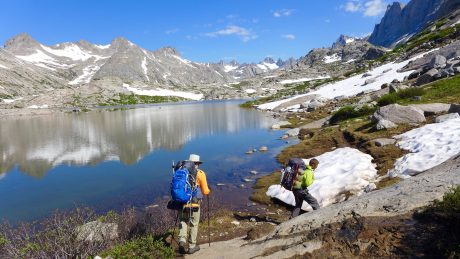

It’s impossible to not feel tiny in this country. And, as writer Cheryl Strayed so eloquently wrote, this has the reverse effect of making me feel gigantic inside. Huge, granite mountains towered above us as we hiked, and only a wide angle lens has any chance of capturing the alpine tundra, lakes and mountains in a single shot.

After about 6 miles, we pitched our tents as close to the base of Bonney Pass as possible. Ours was truly one of the most scenic campsites I have ever enjoyed. We were right under the towering Mt. Helen, and other tall peaks.
As I was pitching my tent, I spied movement out of the side of my eye. It was a herd of about 20 goats –- bighorn sheep ewes? I wandered quietly toward them and was able to watch them for some minutes. (see photo or video) We were all excited to see the wildlife, as we had only seen some songbirds, squirrels, marmots and pika, and weren’t expecting to see much in the way of wildlife on this trip.
Here’s a short video clip of the goats:
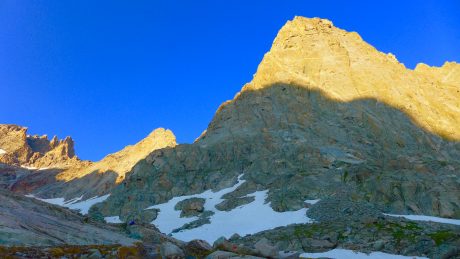
Our camp was surrounded by massive snow fields that adorned the towering peaks that jutted up from the alpine tundra all around us. We had a huge winter in Wyoming this year, and there was still abundant, melting snow all around us. And, close in our sight, was what would be one of the cruxes of our Gannett Peak summit ascent– Bonney (Dinwoody) Pass.
The pass is about 1,200 feet tall, and it’s steep (like in 45 degrees? steep), and mostly covered in snow. I have fitness for hiking up steep hills, but this would be different. We’d have crampons and helmets on. We’d be roped up. We’d have our ice axe at the ready for self arrest, and it would be, well, a serious undertaking, with high consequence should something go wrong.
The other thing about approaching and summiting Gannett from the West side is you have to not only go up Bonney pass, but down it, and across Dinwoody Glacier before you go up to Gannett’s summit. And, well, what goes up and down and up, goes down and up and down on the way back. It would be a truckload of hard-earned effort, and all of it technical and with high consequence.
I’ve hiked literally thousands of miles in these Wind River mountains during the last 20 years, but never had I spied with my own eyes the state’s tallest peak.
Gannett is remote, and very much hidden. So while I was a bit afraid of the task of ascending the steep pass, I could hardly contain my excitement for the sight that awaited me once we crested it.
Not only would I see Gannett Peak, but the map I studied indicated the view I’d get from the top of the pass would be full of glaciers. Last year, I climbed Fremont Peak with a friend, and was blown away when we got to the top of Fremont, and was rewarded by sights of the huge Fremont Glacier, and other glaciers in the distance. That sight had whetted my appetite. I wanted to see more glaciers in my backyard.
We enjoyed another great dinner that night, and we all talked nervously, but excitedly, about the next day’s plan.
I didn’t sleep a wink on night 2 because I just couldn’t wait to see Gannett Peak for the first time. I was just too excited for slumber.
“We cannot lower the mountain, therefore we must elevate ourselves.” – Todd Skinner
Day 3: Whenever I’m traveling, or camping in the wilderness, upon first waking, I always am a little disoriented and have to quickly search my brain for where I’m at. As my eyes first opened on Day 3, and I remembered where I was and what I was doing in Titcomb Basin, the above wise words are what came to mind. The late Todd Skinner was a friend, and a climbing legend, and an inspiration to so many. Today would be the first day of this expedition to really test my mettle.

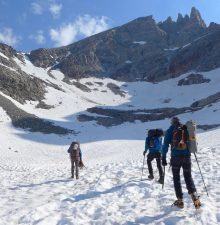
I have leveled up my whole life. By leveling up, I mean I have signed up for or tried things I didn’t have the skills to do. Even though I may look like a fool, stumble, or fail, I believe in doing hard stuff. Abraham Maslow called it self actualizing, when we become actually what we are potentially. We can’t ever realize our potential without leveling up and daring to fail and doing hard stuff we don’t know exactly how to do. In short, I get a lot of fulfillment out of learning, and whenever I level up, I am guaranteed to learn new skills, not to mention more about myself.
Although we wouldn’t climb the mountain until Day 4, we’d start our “climb” today, on Bonney Pass. I was uncomfortable just thinking about what would be required. But as Todd said, we cannot lower the mountain, we have to rise up to meet it.
We were all up early, and Nate had coffee on for us before feeding us a breakfast that included bacon. Yes – you read correctly, bacon! Those who know me know that bacon is one of my favorite foods, so this made me extremely happy. The day was already a winner.
Nate was one of the guides who helped lead me to the Grand Teton’s summit in 2009. I like his style, and he’s very experienced, so although our adventure was full of uncertainties, one certainty was that we were in very capable hands.
During the previous day, and again over breakfast on Day 3, Nate shared and reviewed his vision for our expedition, which was to “slim our loads way down,” making them as light as possible while still carrying tent and sleeping bag, cook stove and food and clothing layers. We’d take our slimmed-down backpacks up and over Bonney Pass, down and across Dinwoody Glacier, before ascending a small outcropped ridge that’s situated about 2,000’ below Gannett Peak. There, we’d put in a camp for the short night before our summit attempt.
Nate explained this would make for a more reasonable summit day on Day 4, not to mention a richer overall experience. (Many who approach from the West side, via Elkhart Park, go up and over Bonney pass, across Dinwoody Glacier, then up to Gannett’s summit, and then all the way back. It can make for a 14-hour day for the most fit, and a 20-hour day for “average” adventurers, especially for those coming from sea level.) Even if we had the fitness for it, it didn’t sound very appealing, and Nate’s vision and reasoning were compelling.
When on a mountain climbing expedition, I want to climb a mountain, but I also want to maximize the experience. I’m willing to wake up at an hour in the wee hours of the morning to get a good start before the sun comes up, but if possible, I’d like for most of the experience to be during the light of day so I can see all of the awe-inspiring sights. I don’t want to experience half of the journey in the dark, and I want to be able to linger at least a little in such an awesome, and hard-to-get-to, setting. Add to that, ascending and descending the treacherous and steep Bonney Pass at the end of a Gannett Peak summit day is hard enough without having to do it twice in a single day. (That’s why when I climbed the Grand Teton in 2009, I opted for the 4-day experience with Jackson Hole Mountain Guides instead of the two-day option. I definitely had the fitness for the accelerated trip, but I wanted an optional summit day in case weather wasn’t favorable, and also, very importantly, I wanted to spend a night in celebration at the incredibly scenic high camp rather than rushing down a steep mountain to re-enter my civilized life more quickly than necessary.)
After breakfast and reviewing our plan, we cached the food and supplies we chose to leave behind, put our crampons and helmets on, and headed toward Bonney Pass.
At first it was easy going. We walked on a gradual uphill to the base of Bonney Pass, and I got used to walking on snow while wearing crampons. Once at the base of the pass, Nate roped us up and gave us some instructions.
Mountaineers rope up to mitigate the risk of of falling on steep, hard snow or ending up in a crevasse. Should a person fall on a steep snow slope, someone, or all, in the roped group will help to use their ice axes to stop the person from falling and/or pulling everyone down the slope with them. Or, if a person were to fall into a crevasse while traversing a glacier, being roped up and spread out will hopefully prevent that person from falling to his/her death or from suffering serious injury.
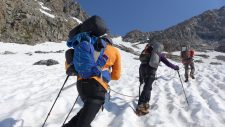
Nate explained we should keep the rope between each of us taut, not slack. Rick and Robert had much more experience with this kind of travel than I did. (They recently summited Mt. Rainier and Mt. Hood.) For me, this roped travel took some practice, but we were soon moving in a pretty good rhythm up Bonney Pass.
This day’s effort would be a quiet one. There’s not a lot of chit-chatting when you’re mountaineering over terrain that is treacherous, and where the risks are high. Intense focus is required. Your mind doesn’t wander. It can’t, and it doesn’t want to. Thankfully.
When we got about two-thirds of the way up the pass, Nate suggested we move to the rocks on the left to finish our ascent of Bonney Pass. Even though the rock was loose and the slope steep, with its own set of dangers, Nate explained the risk was less significant than a fall on the steep snow slope from upper Bonney Pass. So we de-cramponed, and while remaining roped together, scrambled our way up through boulders and over loose rock until we reached the top of Bonney Pass. At the top, we unroped, and Nate instructed us that once we crested the pass, we should take a load off for a few minutes to drink some water and eat a snack.
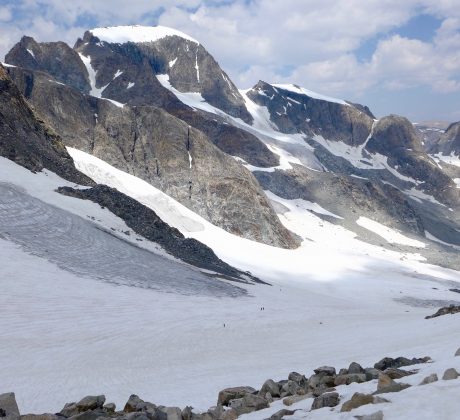
As we crested the pass, the hidden giant that is Gannett Peak revealed itself. It was tall like I expected, but it appeared more massive than I expected. I listened to hear the reaction of Rick and Robert and didn’t hear anything. (One of my very favorite parts about hiking with others in the Wind Rivers, is witnessing their reactions to the beauty that unfolds before them at different points of an expedition.) There was not a peep out of Robert and Rick. I smiled to myself because I assumed they were thinking what I was thinking. Excuse my language, but it went something like this: “Holy Shit.”
I was so excited at seeing Gannett for the first time, and in awe over all of the glaciers that lay before us. There was nothing but snow, glaciers, and towering granite peaks. The sight took my breath away, and mentally, was hard to process. (When I saw the Grand Canyon for the first time, my experience was similar in that I couldn’t find words to describe what I was experiencing, and it took a minute, or more, to fully process that what I was seeing was really real.)
Gannett Peak gets it name from Henry Gannett, who was an American geographer who is described as the “Father of the Quadrangle,” which is the basis for topographical maps in the United States. With 290 miles of isolation from a higher peak, Gannett is the most isolated peak in Wyoming, and the ninth-most isolated peak in the contiguous United States. With 7,076′ of clean prominence, the mountain is the most prominent peak in Wyoming.
It was certainly prominent as I looked at it, in awe.
We didn’t linger because we had a tall order ahead still, and an even taller order the next day. We finished our break, and put on our crampons again. Nate told me I’d go first on the descent. I don’t have much experience with crampons, let alone leading a group of people down a very steep and snow-covered mountain pass. I used crampons briefly, while ascending and descending a gully on my Mt. Whitney mountaineering expedition a few years ago, and briefly on my 2009 Grand Teton expedition, but nothing to this extent.
Did I mention how steep it was? When I asked how to proceed, Nate suggested I just go straight down the pass, with no switchbacking. To start, just try digging your heels in, he said. I used an ice axe in one hand and a trekking pole in the other to help balance myself, and away we went, slowly but surely, down Bonney’s very steep back side.
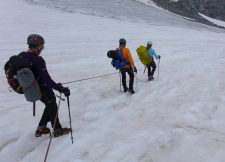
Up ahead, I could see several individuals coming toward us, spread out, appearing as tiny as ants, traversing Dinwoody Glacier.
The snowy slope we descended was full of “snow cups.” The sculpted cupped pattern of the snow resembled ocean ripples, only these were white snow ripples. Often, the snowy slopes we traversed, or ascended and descended, resembled corduroy with extra tall “ribs” that stretched the entire vertical length of the slope. It was beautiful.
By the way, four different times during a two-day period, I saw people I know. The Wind Rivers are vast, and remote, and no matter how many people I might know, I’m always surprised when I see someone I know in the remote reaches of the Wind Rivers. As we made our way down and across the lower portion of Dinwoody Glacier, we passed a guide who was roped up to a client. “Hi Shelli,” the client said. I didn’t recognize him at first because he had a helmet and glasses on, so I said, “Who’s that?” It was Kirk VanSlyke, a former Lander man who was a few classes ahead of me in high school. He now lives with his family in Dillon, MT.
As we continued, silence returned. The day’s work was quiet work. All I could hear was what would become a very familiar soundscape over the next several hours – our measured breathing, and the repeated sounds of our ice axes and crampons digging into the snow.
I noticed the longer I spent attached, literally, to Robert, Rick and Nate, the more connected I felt to them. Each of our safety depended on one another, and even though there weren’t a lot of words spoken when traveling over and through such high consequence terrain, a bond was developing over the course of our expedition. I could feel it, and found comfort in the fact that these guys had my back, and me, theirs.
I also found the single-minded, single-tasking a welcome reprieve from my busy mind. My mind is always thinking and tends to be future-oriented. Traveling on snow and up and down steep terrain, roped to one another, forced me to focus on only the next step, and then the next step, and then next step, for hours at a stretch. It was hard, but also unusual for me – and fantastic. The simplicity of it all was refreshing.
By 2:30pm, we reached the spot at almost 12,000’, situated directly under Gannett Peak, where we would pitch our tents for the short night. This was one of the most scenic campsites I’ve ever had. My tent was pitched under Gannett Peak, which I could clearly see, and on one side was Dinwoody Glacier, and on the other was Gannett Glacier. The rest of the scene was filled in by other glaciers, snow fields and tall, towering granite peaks.
Once we were out of our crampons and on level ground and safe and sound for the time being, I reflected on the day’s adventure. I felt exhilarated. It was a day of leveling up, of seeing new and astonishing sights, and I was filled with anticipation, and nerves, about the summit attempt that was only hours away.
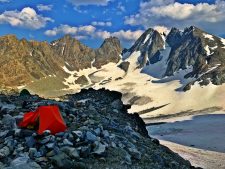
Here’s a short video clip of tentsite at 12,000′, situated under Gannett’s summit and surrounded by glaciers and other tall mountains:
We ate an early dinner that hit the spot – cheesy potato soup with sausage and bacon bits. (Nate’s a great cook!) We reflected on the day’s effort, and agreed on a wakeup time of 3:30am for our summit day. The afternoon and evening were stellar. Blue sky, a fantastic warm and bright orange sunset, and a bright moon bid us good night as we headed into our tents early.
(I am probably being generous, but I think I slept about 20 minutes total. I never sleep well the night before a summit attempt, and well, this summit would be an extra big one for me.)
“You will either step forward into growth or you will step back into safety.” –Abraham Maslow
Day 4: At 3:30am, I woke up from not sleeping, and stumbled out of my tent with my headlamp on to find Nate boiling water for coffee and a quick oatmeal breakfast for us.
I have always wanted to climb things so I can see what the view is from “up there.” Today, specifically, I hoped to stand at the very top of Wyoming.
Our plan was challenging, yet simple: We’d summit Gannett, then return to our tents, break camp as quickly as possible, and continue down and across Dinwoody Glacier, and up and over Bonney Pass.
If it was just a matter of fitness, it wouldn’t be that big of a day. It would be hard, but not exceptional. But we had all kinds of variables to consider, not to mention risks. We’d be walking across and up snow, across and up glaciers, including the very steep Gooseneck Glacier, scrambling up steep sections of boulders and loose rock, and along Gannett’s exposed ridge which marks the final stretch to the mountain’s summit. And that would be just for the summiting portion. Then we’d reverse all of that, plus add some glacier travel, and a steep and high consequence ascent and descent of Bonney Pass at the very end of our day.
I won’t lie, part of why I signed up for a Gannett Peak climb was to push my limits. I wanted to step forward into growth a lot on this trip, and I knew today would deliver that, and then some.
At 5am, with headlamps, crampons and light packs on, we started up the snow to start our ascent of Gannett. After about 10 minutes of snow travel, we removed our crampons, restocked our water bottles from a spring, and then, roped up, and followed Nate up a steep section of boulders and loose rock.
My trail name is “Sunrise.” I got this name because the first light of day is my favorite time of day, and I often insist on starting in the dark so I can be in the wilderness or on the mountain when the sun comes up. So I was a happy camper when we were soon rewarded with a glorious sunrise! (Watching the sunrise made me recall the words of one of my favorite poems, Why I Wake Early, by Mary Oliver, which I know by heart: Hello, sun in my face | Hello, you who made the morning and spread it over the fields and into the faces of the tulips and the nodding morning glories, and into the windows of, even, the miserable and the crotchety – best preacher that ever was, dear star, that just happens to be where you are in the universe to keep us from ever-darkness, to ease us with warm touching, to hold us in the great hands of light – good morning, good morning, good morning. Watch, now, how I start the day in happiness, in kindness.

Next, we crossed a section of snow toward what’s known as the Gooseneck Glacier bergschrund, a crevasse that opens as the summer gets going and the snow melts. Lucky for us, while the bergschrund was starting to open, it had a “snowbridge”near/over it making it passable. The crux of the route begins here. The Gooseneck Glacier / couloir is steep and narrow, and makes your stomach turn when you look down and imagine the what ifs. I took a deep breath, and took some of the most deliberate steps of my life.
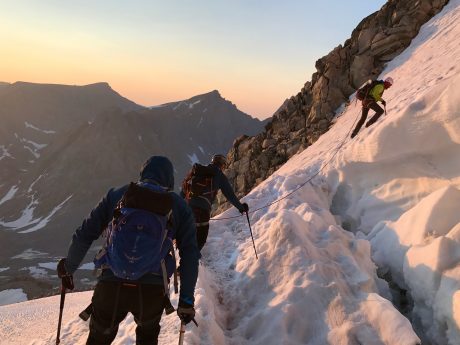
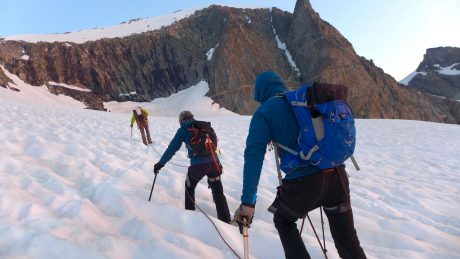
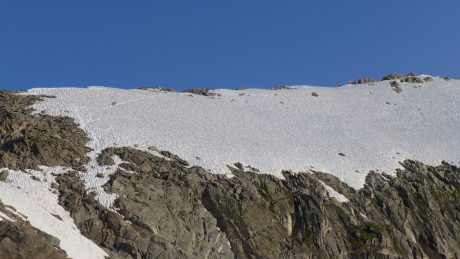
After getting up and through that section, we returned to class 3 rock scrambling, all the way up to the snow-covered face of Gannett, where we put our crampons back on to walk the ridge line to the summit. The final stretch was one of my favorite parts, and certainly one of the most exhilarating. The ridge is narrow, and on the left you can enjoy summit views of lakes and mountains everywhere below. As we made our way to the summit, we’d get glimpses through the rocky ridge on our left to all that was below and beyond. To our right was a steep, completely exposed, snow-covered face.
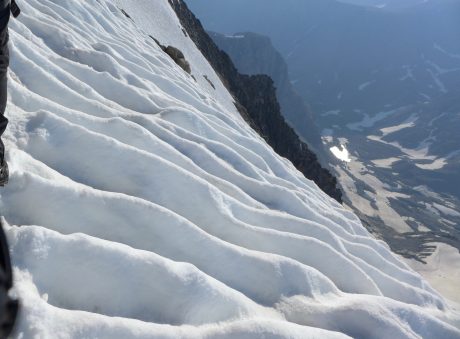
Compared to the rest of the effort, the final stretch to the summit is pretty level, even if it’s extremely exposed. I always feel at my fullest potential right before summiting – when the summit is in reach and right before I stand on it. I felt as though I was on top of the world, even if it was actually just on top my beloved state of Wyoming.
We enjoyed a half hour or so taking in the panoramic views and reflecting out loud about what we had just experienced. I sent a couple of texts with a summit photo to my husband and sons, my parents, etc., and then we reminded ourselves that that summit is only the ⅓ way point. (The saying usually is “The summit is only the halfway point.” And, in fact, most injuries occur on the descent of a mountain.)
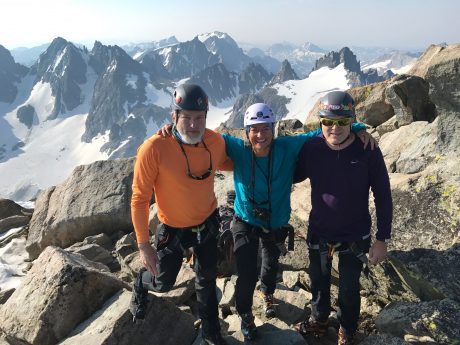
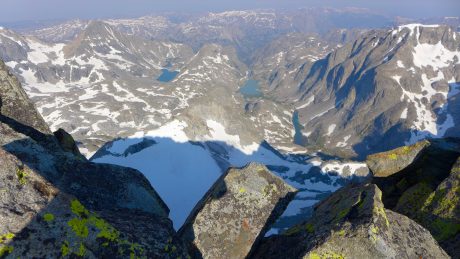
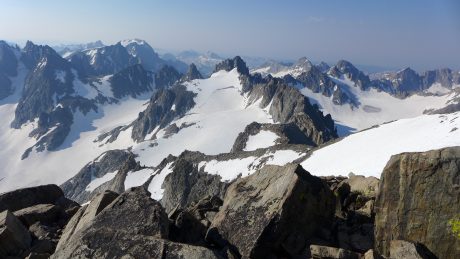
In our case, we had to descend the mountain, break down our camp, and go down, and then up steep Bonney Pass and then descend the steep and treacherous Bonney Pass and eventually get back to our camp, hopefully in one piece, and hopefully before any significant changes in weather. It was a tall order. So we celebrated on top of Gannett, but not for too long, before descending, very carefully, 2,000’ to our tents.
We were methodical and efficient in our descent. After breaking down our camp in short order, we started our return journey.
Just as we imagined, ascending Bonney Pass was a grunt. We took a very short break at the top, and then braced ourselves for what Nate suggested might be the biggest crux of our day – getting safely down a treacherous Bonney Pass on tired legs and lungs. We remained roped up, but removed our crampons at the top of the pass, and followed Nate’s lead down a bunch of rock to mitigate the risk of a steep and dangerous fall on the top of Bonney Pass. About halfway down Bonney, we put our crampons back on and I took the lead and down we went, slowly, but steadily, so as to get this day’s adventure behind us as safely and as soon as possible.
We managed to get back to our main camp at the upper most reaches of Titcomb Basin by 5:30pm. We were all pretty wiped out, but it was great to be on firm and level ground, and finally, to fully celebrate what we had accomplished – standing on the top of Gannett Peak!
As per usual, Nate spoiled us with another hearty dinner. This time it was stuffing, mashed potatoes and gravy. We all ate as if we were very hungry mountaineers. It was a great feast, and we all recalled and replayed the events of the day. We were all filled with joy, but also a sense of relief. We had had success, and suffered no injuries or tragedies.
I shared with the group that my FitBit logged 20,547 steps for the day. And they weren’t just any steps. Every single one of those 20,547 steps were “high consequence” steps. Not many words were spoken during the 12-hour adventure, except for the short time on the summit, and when instruction was offered to us from Nate. Otherwise, Rick, Robert and I were completely focused on every single step. Until then, I had never engaged in such a sustained, high consequence experience. Being on the brink of safety, where the stakes were so high almost constantly, had the effect of making me feel so alive. (By the way, I can’t say enough how impressed I am with Nate, and other guides who must focus on their own individual steps and safety while carefully considering everyone else’s condition and every move.)
I have been fascinated by the concept of flow. Mihaly Csikszentmihalyi, a Hungarian psychologist, named the psychological concept of flow and describes it as “a highly focused state.”
Recently, I’ve read books about flow, including The Rise of Superman, and a more recent follow up book, Stealing Fire.
There are 17 triggers that can lead to flow state, and by all indications, this mountaineering experience we were having included several of them. One thing that is required to reach the flow state of mind is intensely focused attention. Check. Another flow trigger is having a clear goal. Check. We were very clear about our goal. There was no wondering about what our plan was each day on the expedition. Another trigger is the challenge-to-skill ratio. Check. For flow to occur, you need to be doing something that is harder than you’re capable of doing – that requires skills you may not yet have. This will prevent boredom while keeping you engaged and at attention for long periods of time. Another requirement for flow is high consequence. Check. Since we left our camp in the morning, every single step we took, and there were thousands according to my FitBit, were of high consequence. Rich environment is another flow requirement. Check. We were surrounded by a unique environment, rich in glaciers and tall and beautiful mountain peaks. Deep embodiment is another flow trigger. Once again, check. Deep embodiment means total physical awareness. This is when we harness the power of our whole body and pay attention to the task at hand. This also means paying attention to multiple sensory streams at once. No question, my senses were heightened every step on this day. I never felt so alive… even if I was mentally exhausted when we finally returned to our Upper Titcomb Basin camp.
But I digress…
While it was a physical endeavor for me, Gannett taxed me mentally more than it did physically.
So no surprise, once I could let my mind loose, I slept. Hard.
We all slept in, and it was a blissful experience. We had coffee and ate breakfast, and had one of many great mealtime conversations. As is often the case, the deeper we got into the expedition, the more we each let our guards down, and the more meaningful our conversations became.
Around lunch-time, we broke camp and started our 6-mile hike back to our original camp. We all were still high from our accomplishment and the shared experience. Since today’s was a hike rather than a mountain climb, there were more words. At times we hiked together, but at others we spread out. I don’t know about Rick, Robert and Nate, but I spent my hike on Day 5 replaying the previous days’ events, and recalling the scenery I saw, and also taking notice of all of my spectacular surroundings.
I often go to the wilderness to be alone. I think Solitude is the medium for self realization, and I often yearn for time alone. I have a lot of natural enthusiasm and energy, but I also suffer depressive periods every now and again. I know from experience that getting away and going into the wilds is medicine for my soul. I think about this as I walk alone ahead of the group on Day 5. These days in the wilderness have done me good.
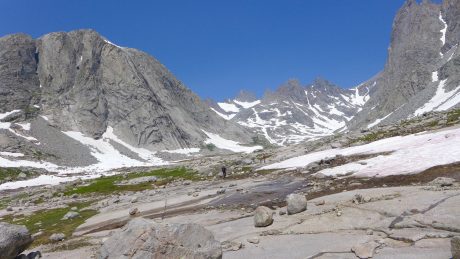
I was reminded of a quote I highlighted in one of my favorite books, a Field Guide to Getting Lost, by Rebecca Solnit:
“As you step up to the ridgeline… The world doubles in size.”
I knew I would return from this trip as more than I was before.
We had a glorious last night in the wilderness. We had a pasta dinner, and chocolate for dessert, and then enjoyed a sunset that painted the granite walls and peaks around us a deep pinkish-orange. The moon was bright, and almost full. Rick and Robert and I enjoyed the sunset together, and shared more stories and memories with one another, in between our reflections of what we had all experienced and accomplished together.
Here’s a short video clip of our last night in camp:
I went to my tent feeling extra blessed. I had not only climbed Wyoming’s tallest mountain, but I also made two new friends, and reconnected with a guide I deeply respect. I especially felt grateful for my family, who lovingly supports these adventures I want to experience, and felt, once again, restored and rejuvenated by my beloved Wind River mountains.
Day 6: Our last day’s hike out was about 13 miles. I couldn’t wait to see Jerry and the boys. They hiked in to meet me when I had about two miles left. They are the best support team a person could ever dream of having and I had a few happy tears when I spied them coming toward me.
(Side note: I was hiking particularly fast on this last day not only because I was eager to be reunited with my family, but also because I was chasing/trying to hunt down a friend of mine that I’ve never met in person. Her name is Kara, and she lives in New York. We have common interests and some mutual friends. Before our respective expeditions, we compared notes and discovered we’d both be somewhere in the Titcomb Basin region on Aug. 4 and early on the 5th. I looked for her on the trail on Aug. 4, but to no avail, and I tried to catch her on my hike out on Aug. 5. I had asked many incoming hikers if they had seen a group of four women, including one with braids and a headband, which is how Kara described herself when we agreed by email to look for each other “out there.” At one point, a hiker informed me that Kara and her group were only 1.5 miles ahead of me, but that was with only about 3 miles remaining to the trailhead, and unfortunately, I couldn’t close the gap!
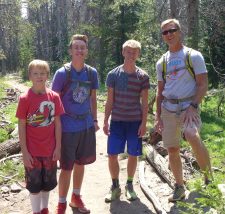
As if seeing my family wasn’t enough to make for a perfect ending to my Gannett Peak expedition, Jerry had a cooler of cold beers, an assortment of fresh fruit, and bags of salty chips ready for Nate, Robert, Rick and I at the “finish line.”
As I wrap this up, I’m also grateful for friendship, and the two new friends I made in Robert and Rick. I am looking forward to keeping in touch with them. I also am grateful for Nate, and for his skills and his leadership. Without him, I couldn’t have made this dream come true.
Why I Pursue “Epic” in My Life

One of my favorite words is EPIC. I probably drive people nuts because I say it (as well as stellar) so often. Even my new business (Epic Life) even has the word in it. I have a lot of epic in my life. This is by design.
By epic, I mean something beyond scale, bigger than anything you’ve done before. By epic, I mean so difficult it will require, at times, a heroic effort; so difficult its outcome is uncertain; so difficult it will require skills you don’t currently have; so difficult it cannot be done alone — it requires a team. For all of these reasons, epic means unforgettable. You will never forget the experience.
One of my foremost passions is long distance day hiking. I like to hike far and fast in a single day. Some of my recent epic adventures include a 45-mile Grand Canyon Rim to Rim to Rim, a 50-mile traverse (day hike) of Zion National Park, a 32-mile Traverse day hike of Wyoming’s southern Wind River Range, a 2-week NOLS backpacking expedition in Alaska’s vast and remote Brooks Range, and many others. I also skate skied 50 miles in a day last winter.
I should say that, being from Lander, WY, where there are many world-class athletes in various outdoor pursuits, at least in Lander I consider myself merely “normal.” But most people, regardless of location, have the same reaction when I tell them of my love of hiking 30-50 miles in a single day. They look at me like I’m whacked, with confusion.
I’m developing a leadership coaching business for women that, as part of a package, will provide epic adventure(s). Recently, when telling a colleague about my plans, she responded with, “What I don’t understand is why you do these things.” In not so many words, she was saying this will be important for my marketing. (Thank you Debbie Cohen).
So, I’ve been thinking about this question. Why do I do these epic adventures? Here is my list of reasons. Of course, it is epic. 🙂
• Health benefit. To embark on an epic adventure, I need to be in great shape. This fact keeps me training at a high level throughout the year so that I can consider any audacious adventure that presents itself to me or that I find intriguing. Being super fit also ensures I’ll be able to keep up with our three young sons and my ambitious husband. (I wasn’t always this fit. It takes determination and commitment. But my level of participation – in all aspects of my life – has increased and improved as a result of my commitment to good health. I highly recommend it. It also helps when it comes to recovery. My legs were tired, but not sore, after the recent Zion traverse.)
• It’s a lot of work. I love the process of working, and the harder, the better. There is something about my heart pumping and the feel of my muscles working, my mind alternating between wandering and focusing that happens on these epic outings that makes me feel very alive.
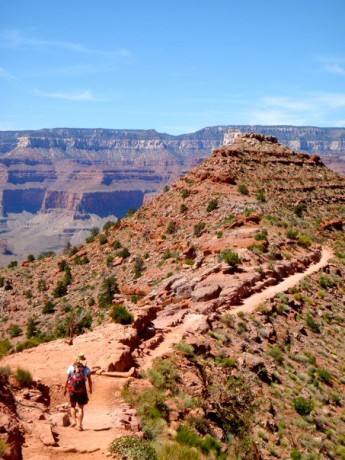
• Nature. My senses are most alive when I’m outdoors in a spectacular natural setting. I’m talking about natural beauty that can move me to tears just by looking at it and taking it all in. The fresh air on my skin, the scents of the landscape and the songs of birds and sounds of animals are all present. It’s a very real connection I experience with nature.
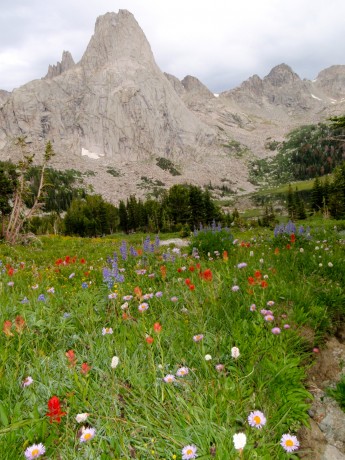
• Mind clearing. You know the saying – “wherever you go, there you are” (Jon Kabat-Zinn). I show up to the trail with all my “stuff.” There could be lots on my mind, not much, all good, all bad, nothing special, something that is really special – whatever. Me, and all that matters to me in my world, show up. As the adventure gets under way, the solitude I’m afforded (which is provided even when I’m hiking with others) enables thoughts to get organized (“mapped”) in my mind. Mostly this is unconscious for me. Thoughts that are most pressing will rise to the top.
I can consciously choose to focus on something and try to keep my mind on that topic, or I can let my mind wander and let thoughts lead and lay where they may. The former takes effort as my mind wants to wander when I’m in open space, moving in a place surrounded by huge vistas. By the time I’ve completed the hike, I’m much more clear on many things. I have solved problems, prioritized, come up with brainstorms for solutions, written blog posts, re-played conversations that are important, made discoveries, etc.
• Camaraderie: It is amazing to share an epic adventure with other like-minded people. All of the epic adventures I’ve been on with others have provided a social aspect, as well as opportunities for solitude. The conversations that occur and that are shared along the trail add to the experience and the memories.
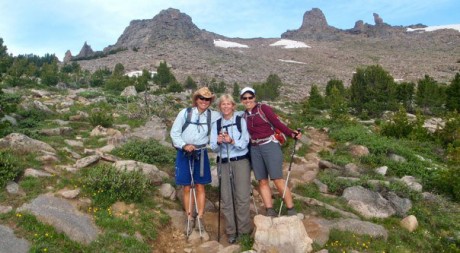
• Humility. In the natural places I’ve been and am drawn to, the views are remote and natural and rugged and enormous in scale. I feel insignificant in size, both with respect to the country that surrounds me, but also to the task at hand. This experience humbles me. I love that it does.
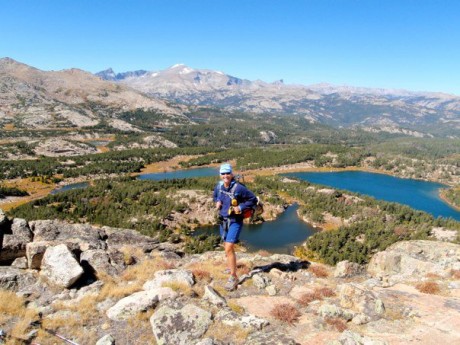
• Pilgrimage. The longer and harder (the more epic) the adventure, the more spiritual it is for me. Because the adventure is hard work and is very much a struggle, I become vulnerable. I find myself in an awe-inspiring place, with my senses completely awake, yet weak due to the effort. I always discover new truths about myself during this struggle.
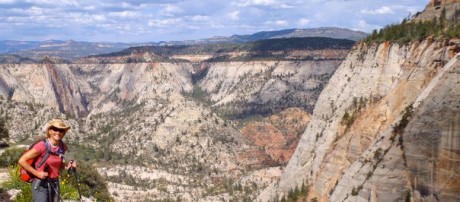
• Mental toughness. Or, shall we say, an epic adventure provides an opportunity to practice “mind over matter.” During these epic hikes, there is always a crux, sometimes more than one, when things are at their most difficult, and I find that I am at choice. I want to quit. I have completely blister-damaged feet, or my legs hurt, or I’m out of energy, or it’s too arduous of a task to continue or finish, it’s closer to the start than the finish, or all of the above.
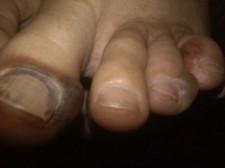
During these hardest times of the hike, the negotiations in my mind start. (And I’m a pretty effective negotiator!) I start arguing and settling and negotiating and reasoning with myself in my head. Examples: Well, if I don’t do the full 50 miles, that’s okay – 42 miles with this much elevation gain and loss is pretty awesome. Or: Well it was a long winter and I’ve only logged one 20-mile hike so far, so it would still be awesome if I were to stop after 36. Or: These conditions suck. There is no way anyone would finish this on a day like this, in these conditions.)
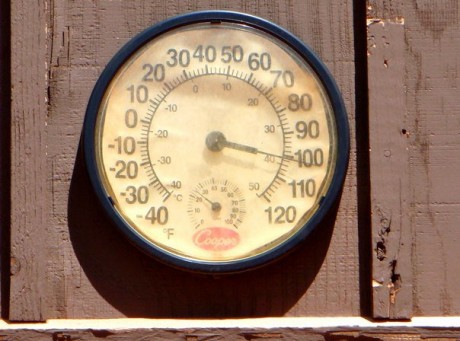
This crux – this place I describe above – is a very powerful place to be. It’s when I’m reminded of the many survival stories I’ve read and been in awe about, including the likes of Ernest Shackleton’s Endurance or Unbroken, the survival story about Louie Zamperini. I think of these stories, and others, and talk about getting perspective real quickly! Suddenly my issues are tiny in size. And, it’s during this stage that I’m reminded that, in fact, we are at choice. Come to think of it, my being there was a choice. (Read VIKTOR FRANKL’S MAN’S SEARCH FOR MEANING, which in so many words states that, Forces beyond your control can take away everything you possess except one thing, your freedom to choose how you will respond to the situation. You cannot control what happens to you in life, but you can always control what you feel and do about what happens to you.)
During the crux (meltdown) of an epic adventure, the question I often ask myself is, How do I want this story to end? What is the story I want to tell about this? Of course as a writer, this context makes sense. The point is I get to decide, which is not always easy, especially since it would be easier to quit. On the Grand Canyon Rim-to-Rim-to-Rim, I had major blisters on both feet by mile nine, and before the half-way point, both of my feet were totally blister-damaged. Every step (millions?) felt as if I were standing on needles or burning coals. However, for me, it’s often harder to quit and have the ending I don’t want, than it is to suck it up and do the rest of the work. (Please take note that blisters do not cause permanent damage so I didn’t view my continuing as reckless, just very difficult and painful.)
The power is in the fact that this is a choice that I get to make and that I live with that choice. I like the power of this and it serves as a metaphor for all the choices we get to make in our lives. (By the way, I have not always chose to end stories with “happy, successful endings.” I quit the Tahoe 50-mile run at mile 42 due to heat ailments, and I quit the Run to the Sun 37-mile event after 27 miles, because, well, I just didn’t want to finish. I learned from these non-finishes despite the fact they were not the endings I was going for.)
In short, these epic hikes provide me with practice for life’s challenges and hardships.
• Accomplishment. When I finish something that’s, by my standards, epic, I am a better leader as a result. This translates also into increased confidence that helps in all aspects of my life.
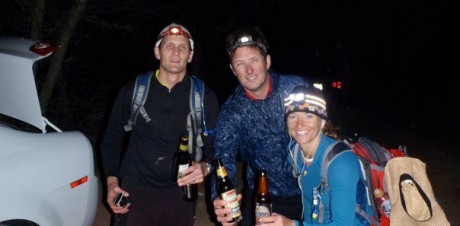
• Gratitude. Often, near the end of an epic adventure, some tears are shed. Most of them come as a result of gratitude that overwhelms me. Physical hardship (which causes vulnerability), natural beauty, and solitude combine to fill me with gratitude, especially for my family and friends, my abilities, the opportunity to have this experience, the scenery that surrounds me — not to mention that near the end, success is almost for certain! The final stage of the epic adventure becomes very personal, and devotional, for me.
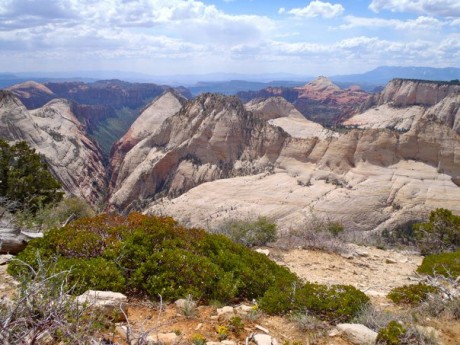
• Becoming More, and Better.
Finally, the biggest reason I choose to pursue epic is because doing so causes me to become more, and better, than I was before.
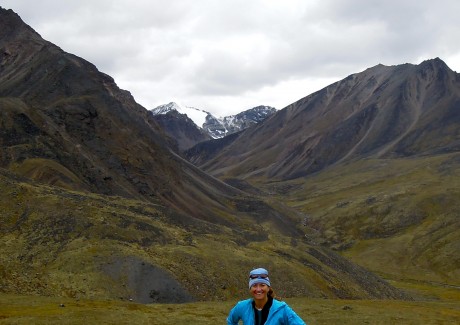
So, there you have it. These are the reasons that I choose to do these epic adventures. There is no question I am better for them. I am healthier, have improved leadership, confidence and participation in my own life, have collected some interesting stories to share, have seen sights so stunning that they continue to inspire me, have formed lasting friendships as a result of these adventures, and feel more alive than ever. I have experienced change, and have grown. I am energized and fulfilled. It is my aim to facilitate the same epic experiences for my clients. (BTW, epic means different things for different people. An epic adventure for a client might be an eight-mile hike at altitude. Or more. Or less.)
I would love to hear your thoughts on epic adventures. Have you embarked on one? And, how did it affect and/or change you?
———————————————
Epic Life, provides coaching that dares its clients to live as if they’re dying — as if every day counts. Epic Life dares you to go off-trail and uphill, to choose your own way even if it’s the hard way — especially if it’s the hard way. It’s about going farther than you’ve ever gone before. Epic Life is about changing your world. It’s about changing the world. Epic Life is about creating a life that takes your breath away — a life that is epic. Email me if you’re interested in learning more.